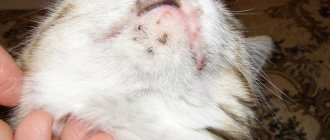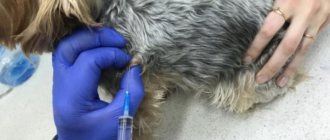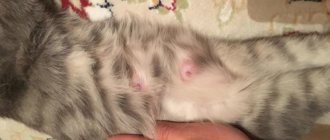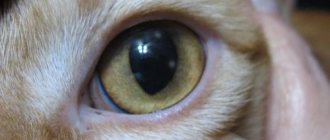Various wounds and other damage to the skin are the most common reason for a cat owner to contact a veterinarian. Naturally curious and active animals, they constantly expose themselves to the risks of injury.
Wounds in domestic cats are not a rare occurrence and all owners of mustachioed pets have encountered it. The cause of a wound in a cat can be damage in everyday life, fights with relatives or yard dogs.
Much will depend on the origin of the wound, its size and depth, as well as the possibility of introducing pathogenic microflora into it. In particular, a veterinary specialist, based on the results of the clinical picture and laboratory tests, prescribes an adequate therapeutic course, which, in turn, will prevent serious complications associated with a cat’s wound that is not treated in a timely manner.
What to look for
Fresh wounds usually appear partially or completely:
- Bleeding
- Swelling
- Lack of hair
- Cut, scratched or torn skin
- Lame
- Tenderness or pain
If a fresh wound is not visible, it may become infected.
In addition to swelling and soreness, you may experience the following:
- Discharge (pus) from the wound
- Abscesses (that is, a collection of pus under the skin) and the resulting hole in the skin when the abscess is opened and drained.
- Signs of a fever (such as lethargy and ears that feel hot to the touch)
How to tell if a cat has a wound
Newly acquired wounds in pets have certain signs and characteristics that are difficult to ignore or not notice:
- swelling; - purulent discharge; - presence of bleeding; - painful sensations; - torn, peeled skin; - change in gait, limping; - increased anxiety of the animal; - bald spots, hair loss in some places; - reluctance to let the owner near any part of the body.
Read more about the signs of an unhealthy cat: Signs of an unhealthy cat
First aid
What you can do at home ultimately depends on your cat. Sometimes the only thing you can do is wrap your cat in a towel or put him in a carrier and take him straight to the vet.
However, there are a few things you can do if your cat will let you, especially if it will be a while before you can get to the vet.
If there is bleeding, apply pressure to the wound. Cover the wound with sterile gauze or a clean cloth and apply pressure. It may take 5–10 minutes for the bleeding to stop.
Once this happens, secure the gauze with tape; removing it may remove the clot and bleeding will resume.
Check for other wounds.
If there is no bleeding and the cut (tear) or scrape (abrasion) appears minor, try cleaning the wound.
Use an antiseptic solution or plain water and gauze or cloth (not cotton) to gently clean the area around the wound, and a syringe or similar device to flush the solution over the surface of the wound.
Antiseptic solutions are prepared by diluting store-bought concentrated solutions containing either povidone iodine or chlorhexidine diacetate as the active ingredient.
Do not use alcohol or hydrogen peroxide on wounds as they may damage tissue. Povidone should be diluted to the color of weak tea; Chlorhexidine should be diluted to a pale blue color.
If the wound is long or deep , or if it is a puncture wound, you can clean the edges as already described, but do not clean the wound itself. Let the vet do it.
Once you have done everything possible, take your cat to the vet.
About the need for surgical intervention
If an unpleasant odor emanates from the wound and the animal’s condition begins to give rise to concern, it is imperative to take the pet to the veterinarian. The specialist will be able to treat the wound canal; he will completely remove dead and destroyed tissue. In short, after surgical treatment, conditions will be created for healing by primary intention.
To eliminate the possibility of re-development of pathogenic microflora, the animal is prescribed a course of broad-spectrum antibiotics (of course, it is advisable to grow a culture of the pathogen before this). It is possible (provided that the pathogen reacts to them) to prescribe sulfonamide drugs to the pet. Sometimes comprehensive treatment can be more effective.
In milder cases, tampons soaked in syntomycin liniment or Vishnevsky's balsamic liniment are applied to the wound itself . These agents draw off pus or necrotic exudate. If for some reason applying ointment is impossible, you can use a saturated solution of ordinary table salt or even sugar for this. The latter is also a strong preservative and in high concentrations prevents the growth of bacteria.
It is also advisable to treat the surface of a weeping wound daily with a 3% solution of hydrogen peroxide. This must be done very carefully, soaking a cotton swab in the medicine. It is important to try not to irritate or injure the cat again. It is important to emphasize that in any case it is necessary to prevent licking and scratching of the wound, especially when it is on the face. For this purpose, a surgical (Elizabethan) collar is placed on the pet’s neck.
Veterinary assistance
Diagnostics
Your veterinarian will carefully examine your cat and evaluate any wounds found. Your cat will also be examined for other problems.
For proper assessment, the cat's fur must be shaved. Some wounds may require x-rays. The examination may also require sedation.
Treatment of wounds in cats
The main goals of treatment are to prevent infection and promote healing. Different types of wounds require different methods to achieve these goals.
In most cases, your cat will need sedation or anesthesia to ensure the wounds are treated safely and without causing further pain.
-Minor scrapes and cuts often require nothing more than a thorough cleaning and perhaps a little leather glue to hold the edges of the cut together.
- Long and/or deep cuts require careful cleaning to ensure there is no debris in the wound and careful examination to determine the extent of the damage. If the wound is less than 12 hours old and not heavily soiled, it will probably be closed with a closed suture.
— Puncture wounds, especially from animal bites, often have extensive damage under the skin that is not visible upon initial examination. After removing any possible foreign material, these wounds should be carefully examined and then thoroughly washed with copious amounts of antiseptic solution. Sometimes these wounds need to be opened surgically to treat deep tissue damage.
— Meanwhile, puncture wounds and/or wounds older than 12 hours that are contaminated or have signs of infection, abscesses, or large areas of skin missing are usually not sutured. Instead, they are covered with bandages until the wound has healed or the wound is healthy enough for the stitches to actually help the wound rather than trap the infection inside.
- Large or deep wounds, contaminated wounds or multiple puncture wounds often require the placement of a Penrose drain, which is a soft rubber tube that allows excess contaminated tissue fluid to drain out and leaves a small opening for flushing antiseptic solution through the wound. .
Your veterinarian will prescribe medication for your cat for infection and possibly pain, which you will need to continue to give at home.
Most cats are released within 24 hours of admission.
What is a wound
A wound is an injury that results in a violation of the integrity of the skin or mucous membrane. There are several types of wounds in kittens:
1. An incised wound is the result of injury with a sharp object (knife, razor). This type of damage heals quite quickly, since the tissue is almost not destroyed. 2. A puncture wound appears as a result of interaction with a long and sharp object (an awl, a knitting needle). Such damage is characterized by a small wound area on the surface of the body and a relatively large depth. 3. A chopped wound is the result of a strong impact from a sharp object at an angle to the tissue. It causes severe pain and bleeding. 4. A bruised wound appears from a blow to the body with a blunt object. Muscle tissue is crushed, which increases the chance of wound infection. 5. A crushed wound is the same as a bruised one, but with more severe damage and much more extensive. 6. Bite wound - damage received during interaction with other animals. It has its own danger - infection can occur with the microflora of the attacking animal's oral cavity. Therefore, complications often occur with this type of wound (rabies, tetanus, etc.).
Read more about infections in cats: What you need to know about cat infections
7. A poisoned wound is the result of contact with an animal toxic substance (snake bite, household chemicals) on the damaged skin. 8. Gunshot wound.
There are also mixed types of wounds that combine signs of several types at once. Cats can get injured in different ways: in fights with other cats or dogs, while climbing trees, roofs and fences, carelessly jumping from shelf to shelf in an apartment, and so on. Damage can also be caused by falling from a height or getting hit by a car (such wounds are most often crushed or bruised). As you can see, the vast majority of potentially dangerous situations where you can get injured are waiting for cats on the street. Let's talk a little further about how to minimize the risk.
Caring for a sick cat
The most important thing you can do when your cat comes home is to make sure she is well cared for. Fortunately, this usually takes 1-2 weeks. Good nursing care includes:
— Do not allow your cat to lick, chew, or scratch wounds, stitches, dressings, or drains. This may require the use of an Elizabethan collar.
- Keep dressings clean and dry and change them as directed by your veterinarian. Initially this may be 2-3 times a day. You may need to take your cat to the vet for changes, especially if he is uncooperative. If the bandages become wet, or you notice an odor, chafing, or increased drainage (or the drainage does not subside), take your cat to the veterinarian for an examination.
— Apply a thin layer of antibiotic ointment to the edges of the wound once or twice a day, but only if the cat cannot lick it off.
— Make sure your cat is receiving all of its prescribed medications. If you have problems administering it, contact your veterinarian.
If the wounds are not serious or complications do not develop, here is a typical schedule of activities after visiting the veterinarian:
— Penrose drains are removed 3-5 days after their installation.
— Sutures are removed 10–14 days after application.
- Antibiotics are usually prescribed for 7-10 days.
- Painkillers, if used, are usually prescribed for 5-7 days.
- Dressings can be left in place for anywhere from 24 hours to several weeks, depending on the nature of the wound. Changing the dressing should begin at least once a day; longer intervals between changes may be possible later in the healing process.
If a wound, especially a puncture wound, is not noticed and your cat is not taking antibiotics, an abscess may form, resulting in the symptoms described at the beginning of this article.
Abscesses take 10 to 14 days to develop and are often not noticed until they rupture. An abscess will require a return visit to the vet.
The diet of a cat with purulent wounds also affects the treatment of purulent wounds in cats
A cat with festering wounds is very sensitive
.
All smoked meats, sausages, sweets that should not be given to even healthy cats, and fatty meats should be removed from the diet. A festering wound will heal faster if you eat healthy, natural foods, for example, vegetables, boiled chicken, and fish. Remember healthy, dietary food in hospitals and sanatoriums. You will never find sausage or unhealthy smoked brisket there. During the period of active recovery, it is very advisable to give your pet synthetic vitamins that will help maintain the health of the furry.
What are the types of ulcers?
The main types of skin ulcerative lesions are shown in the table:
| Variety | Peculiarities |
| Simple | Heals quickly, leaving a scar |
| Bacterial | Characterized by the appearance of pus, does not heal well |
| Edema | Covered with a granulation structure that can be easily destroyed with a finger |
| Decubital (bedsore) | Develops due to impaired blood flow due to prolonged immobility of the animal |
| Gangrenous | Characterized by necrosis of areas of the skin of the abdomen |
| Can be dry or wet | |
| Neurotrophic | Occurs due to nerve damage or malnutrition of central nervous system tissues |
Neoplasms
Proliferative ulcerated skin lesions in cats, especially solitary lesions, should always raise red flags for neoplasia. Blastomatous ulcers are formed as a result of the breakdown of tumor tissue. Cytological signs of malignancy of neoplasms are: anisocytosis (change in cell size), pleomorphism (change in cell shape), change in the color intensity of the cytoplasm, anisokaryosis (change in the size of the nuclei), change in the size and shape of the nucleoli, change in the value of the nucleus/cytoplasm ratio. The most common examples of tumors leading to the formation of ulcerative skin lesions in cats are basal cell carcinomas (photo 5), squamous cell carcinoma, mastocytomas (photo 9), less commonly ceruminomas and tumors of the sebaceous glands, tumors of mesenchymal origin (fibrosarcomas, angiosarcomas and others). Erosions and ulcers in the abdominal area, accompanied by lumps in and under the skin, are often associated with breast carcinomas (Figure 7).
How to treat?
Surgical intervention
Surgery is prescribed if it is necessary to open an abscess. An incision is made into the formation and the pus is squeezed out. A suture is applied to stab wounds. To prevent the animal from licking its belly, it is recommended to wear a special bandage. To speed up the regeneration process, you can lubricate the seam with Yoddicerin.
Drug therapy
All medications are prescribed by a doctor. Sores should be treated with the drugs shown in the table:
| Pharmgroup | Name |
| Antihistamines | "Clemastine" |
| "Chlorpheniramine" | |
| Against ticks | "Stronghold" |
| "Demos" | |
| "Neotsidol" | |
| Sulfuric ointment | |
| Hormonal | "Trilostane" |
| Antibiotics | "Levomekol" |
| "Miramistin" | |
| Against deprivation | "Fungin" |
| "Clotrimazole" | |
| "Sanoderm" | |
| Ointment "Yam" |
Diseases with skin lesions
It is worth taking a closer look at the health problems that cause the uncharacteristic appearance of the skin and coat. Each illness negatively affects the external and internal condition of the pet.
Bacterial and fungal infections
Infections with pathogenic organisms occur in different ways. For example, the dry type of infection causes the appearance of dry, compacted crusts on the surface of the body. The wet form is characterized by redness, ulcers, scratching and severe itching. The reasons for the penetration of infections are varied:
- metabolic disorder;
- diabetes;
- neoplasms of various types;
- weakened immune system;
- superficial wounds.
Treatment is carried out only by a veterinarian after a thorough examination and laboratory tests. One of the most unpleasant and contagious lesions is lichen, which is transmitted to other animals and humans.
It is impossible to choose on your own how to treat a cat’s scratching: to do this, you need to determine the type of pathogen. This can only be done in a veterinary clinic laboratory.
Parasites in cats
One of the most common causes of wounds on a pet’s body is parasites that choose warm areas on its surface. For example, the neck and axillary parts are very attractive to them. Parasites are external blood-sucking pests - fleas or mites, including scabies).
It is not the fleas themselves that cause discomfort, but the products of their activity. The saliva released when a wound is bitten contributes to the onset of allergic irritations. The pet scratches in this area due to severe itching. This is how pathogenic microorganisms appear in the wound, which trigger complications of the disease.
Skin pests are easy to spot. To do this, you just need to examine the body and head of your mustachioed friend. If parasites appear, it is necessary to carry out timely treatment to stop the spread of the infection. In any case, it is important to consult a veterinarian. He will examine the patient and determine that the appearance of sores in the cat is indeed associated with bloodsuckers.
Ticks are much more difficult to see. Subcutaneous individuals are found only by a doctor after a thorough examination and special tests. Treatment is most often prescribed in the form of drops on the withers or tablets. The drug "Ivermek", which is used as intramuscular injections, has proven itself well. The course of injections is 30 days, during which 3 vaccinations are given with a medicinal solution.
A similar product can also be purchased in the form of an ointment or gel. It is applied to the damaged surface after consultation with a veterinarian. Do this at home strictly according to the instructions.
It is important to remember that fleas do not pose a direct threat to your pet's health, but scabies can lead to death. Ticks not only spread under the skin, but also parasitize internal organs, so it is important to start treatment as soon as possible.
Allergic manifestations in cats
Sometimes sores on a cat’s skin occur due to allergies to external irritants. For example, purchasing a new brand of industrial food can lead to malfunctions in the body, which will manifest itself in the form of skin pathologies. It is possible to determine the cause of such a reaction by visual inspection and conducting special tests to recognize the allergen.
In addition to food, the body can react to dust, chemicals or hygiene products. Even inhaling ordinary washing powder leads to unpleasant consequences. There are times when sensitive cats react to blooms. The test, performed in a hospital setting, will identify a group of foods or other substances that need to be removed from the pet. If this is not done, the cat will have to be constantly given medications.
Dermatitis in animals
There are different types of skin dermatitis. Some of them have no complications, while others lead to death if treatment is delayed. They can be both bacterial and fungal, and are also caused by mechanical damage.
The bacterial type of dermatitis manifests itself as ulcers on the body and head of the pet. Animals with weakened immune systems, as well as babies under 1 year old, are at risk of getting sick. Once the pathogen is identified, the doctor prescribes antibiotics.
Less dangerous, but just as unpleasant, are dermatitis caused by seborrhea or injury. In the first case, the cat develops dandruff, and the animal begins to constantly itch in different places. In the second case, a simple wound can fester and cause sepsis, which in many cases leads to death.
Acne on a cat's body
Acne is blackheads with hard crusts. Acne with the appearance of open and closed comedones is usually localized on the neck, chin and lips of the cat. The cause of acne is considered to be poor hygiene, infections, stress, and abnormalities in the sebaceous glands and hair follicles. Even low-quality plastic from which the bowl is made can cause acne. Contact with cheap material can cause unpleasant rashes - it all depends on the sensitivity of the individual.
Another symptom is slight hair loss. If the disease is not treated, ulcers, purulent pimples, inflammation, and bacterial infections appear. After making a diagnosis, the veterinarian prescribes antiseptic detergents: medicated shampoo, soap. In addition, lips, chin and other areas affected by acne are treated with Miramistin or Chlorhexidine.
Other lesions
Even psychogenic factors cause ulcers and crusts on a pet’s body. For example, Cushing's syndrome is manifested by baldness of certain areas of the skin. Fortunately, this syndrome is rare in pets: it appears due to too much of the hormone cortisol. The disease has other pronounced symptoms:
- strong thirst;
- frequent urination;
- constant feeling of hunger with subsequent enlargement of the abdomen;
- lethargy, muscle atrophy;
- thin skin, baldness.
Doctors often prescribe medications that can suppress large releases of cortisol into the blood. In severe cases, the pituitary gland, adrenal gland are surgically removed, or chemotherapy is used.
Another skin problem is alopecia. Loss of fur also occurs under the influence of neuroses. They can be caused by a change of place of residence, the appearance of a new owner, or meeting a new family member. Some breeds are most prone to pathology: these are Abyssinian, Himalayan and Siamese cats.
Baldness is focal. Most often it appears on the abdomen, groin area, sides or inner thighs. Sores rarely appear on a cat's neck. The medications Kot Bayun, Amitriptyline, and Stop-Stress help to cope with the problem.











